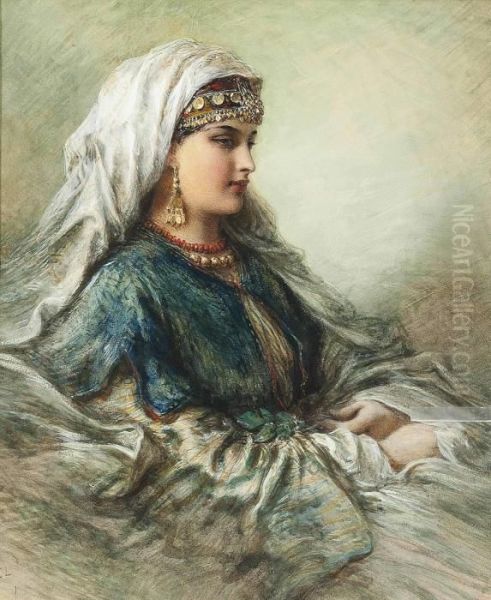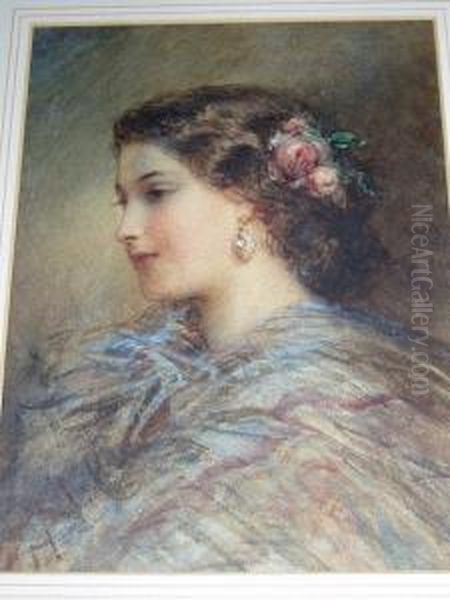
Egron Sillif Lundgren (1815-1875) stands as a fascinating figure in nineteenth-century art, a Swedish painter whose career transcended national boundaries to embrace the vibrant, often tumultuous, wider world. Primarily celebrated for his mastery of watercolor, Lundgren's extensive travels and keen observational skills allowed him to capture a diverse array of subjects, from the glittering interiors of European opera houses to the sun-scorched landscapes of India and Egypt. His work provides a unique window into the cultural currents, colonial encounters, and artistic practices of his time, placing him in dialogue with many prominent contemporaries.
Early Life and Artistic Awakening in Sweden
Born in Stockholm, Sweden, on December 18, 1815, Egron Sillif Lundgren's early life set the stage for an artistic journey that would take him far from his Nordic homeland. Sweden, during this period, was experiencing its own artistic developments, though perhaps not at the same fever pitch as Paris or Rome. Nevertheless, the Royal Swedish Academy of Fine Arts in Stockholm provided a foundational training ground for aspiring artists. It was here that Lundgren likely received his initial instruction, honing the basic skills of drawing and composition that would serve him throughout his prolific career.
The artistic environment in Sweden, while fostering local talent, also looked outward. Artists like Alexander Lauréus had earlier established reputations, and the romantic nationalism prevalent in parts of Europe also found expression in Swedish art. Lundgren, however, was destined for a more international stage, his talents and temperament drawing him towards the major artistic centers of the continent.
The Parisian Crucible: Formation and Influences
Like many ambitious young artists of his generation, Lundgren was drawn to Paris, the undisputed capital of the art world in the 19th century. He arrived in the city to further his artistic education, immersing himself in an environment teeming with new ideas, techniques, and rivalries. He spent four formative years in Paris, a period critical for shaping his artistic vision and technical proficiency. The city's ateliers, museums, and salons offered unparalleled opportunities for learning and exposure.

During his time in Paris, Lundgren would have been aware of the dominant artistic currents, including the lingering influence of Neoclassicism, championed by artists like Jean-Auguste-Dominique Ingres, and the rising tide of Romanticism, famously embodied by Eugène Delacroix. Delacroix's vibrant color palettes, dynamic compositions, and fascination with exotic, often Orientalist, themes may have planted early seeds in Lundgren's imagination, given his later travels. He also studied under notable masters, though specific names of his direct tutors in Paris are less prominently recorded than his later associations. The academic training he received would have emphasized rigorous drawing from life and the antique, alongside studies in anatomy and perspective.
Italian Interlude: Mastering Light and Landscape
Following his Parisian studies, Lundgren embarked on a four-year sojourn in Italy, another essential pilgrimage for Northern European artists. Italy, with its classical ruins, Renaissance masterpieces, and stunning natural light, offered a different kind of artistic nourishment. Rome, in particular, was a hub for an international community of artists, including a significant Scandinavian contingent. Lundgren became part of the circle of Swedish artists in Rome, a community that provided both camaraderie and intellectual exchange.
In Italy, Lundgren's focus likely shifted towards landscape painting and the study of light and atmosphere, elements that would become hallmarks of his watercolor technique. The Italian countryside, with its picturesque towns and historical sites, provided ample subject matter. He would have encountered the works of earlier landscape masters and contemporary painters who specialized in capturing the Italian scene. Artists like Camille Corot, who spent considerable time in Italy, were developing a more naturalistic approach to landscape that influenced many. Lundgren's time in Italy was crucial for refining his skills, particularly in watercolor, a medium well-suited to capturing the fleeting effects of light and the vibrant colors of the Mediterranean world. He was also noted as being involved with the local militia during his time in Rome, a curious detail that hints at a life lived beyond the confines of the studio.
Spanish Sojourn: Capturing Culture and Character
Lundgren's artistic wanderlust then led him to Spain, where he spent five years. This period was significant for his development as an observer of local customs, costumes, and everyday life. Spain, with its distinct cultural heritage, Moorish influences, and dramatic landscapes, offered a wealth of new subjects. His works from this period often depict lively street scenes, traditional festivals, and portraits of Spanish figures, showcasing his growing interest in ethnographic detail.

In Spain, he would have been aware of the rich legacy of Spanish painting, from Diego Velázquez to Francisco Goya, whose powerful portrayals of Spanish life and society had a lasting impact. Lundgren's own approach was less about grand historical narratives and more focused on intimate, observational watercolors. His time in Spain further honed his ability to quickly capture scenes and characters, a skill that would prove invaluable in his later, more challenging assignments. Works from this period demonstrate his increasing confidence in handling complex compositions and his adeptness at conveying the unique atmosphere of the Iberian Peninsula. He documented scenes in Seville, among other places, capturing the essence of Andalusian life.
London: An Established Watercolorist
Around 1853, Egron Lundgren settled in London, which became his primary base for many years. The British capital was a major center for the art market and home to a thriving watercolor tradition. Lundgren quickly established himself within this milieu, becoming a prominent member of the prestigious Society of Painters in Water-Colours (now the Royal Watercolour Society). This affiliation was a significant marker of his success and acceptance within the British art establishment.
As a leading member of the society, Lundgren regularly exhibited his works at their galleries. Notable pieces shown included Italian Music, Travelling Companions, and A Child's Head. These titles suggest a continued interest in genre scenes and portraiture, executed with the refined watercolor technique he had perfected. His skill and international experience made him a distinctive voice among British watercolorists like David Cox and Peter De Wint, who were renowned for their depictions of the British landscape. Lundgren brought a more cosmopolitan sensibility to the London art scene. His contributions were recognized, and he was honored by the Swedish king, being made a Knight of the Order of Vasa, a testament to his international reputation.
The Indian Mutiny: A Royal Commission
One of the most significant episodes in Lundgren's career was his journey to India in 1858-1859. He was commissioned by Queen Victoria herself to create a visual record of the aftermath of the Indian Mutiny (also known as the Sepoy Rebellion or India's First War of Independence) of 1857. This was a prestigious and challenging assignment, placing Lundgren in the role of a war artist or special correspondent, tasked with documenting scenes of historical importance for the British Crown.
During his time in India, Lundgren served on the staff of Lord Clyde, the Commander-in-Chief in India. This position gave him access to key locations and events. He produced a remarkable series of watercolors depicting landscapes, military encampments, portraits of British officers and Indian soldiers, and scenes related to the conflict. These works are invaluable historical documents, offering a European perspective on a pivotal moment in British colonial history. His painting Sikh Soldiers Bargaining is one example of his ethnographic interest during this period. The Indian watercolors are characterized by their meticulous detail, vibrant color, and ability to convey the atmosphere of the subcontinent. Many of these important works are now housed in prestigious collections, including the Royal Collection at Windsor Castle, the Victoria and Albert Museum, and the British Museum, though their dispersal has somewhat diluted their collective impact.
Egyptian Adventures and Orientalist Visions
Lundgren's fascination with the "Orient" – a common preoccupation among 19th-century European artists – also led him to Egypt. He traveled there with fellow British artists George Price Boys, a notable watercolorist, and Frank Dillon, a painter known for his Orientalist scenes. Together, they immersed themselves in the local culture, even renting an Arab house in Giza and attempting to live in an "Oriental" style. This desire to experience the culture firsthand, rather than merely observing it as a tourist, was characteristic of some Orientalist painters, though it often coexisted with preconceived notions and romanticized views.
In Egypt, Lundgren produced a series of striking watercolors, capturing the ancient monuments, bustling street life, and desert landscapes. His work Sunrise over the Pyramids of Gizeh is a testament to his ability to evoke the grandeur and mystique of the Egyptian scenery. These works align with the broader Orientalist movement, which saw artists like Jean-Léon Gérôme and David Roberts creating highly popular, often meticulously detailed, depictions of the Near East and North Africa. Lundgren's Egyptian scenes, like his Indian works, combine topographical accuracy with a romantic sensibility, reflecting both his observational skills and the prevailing European fascination with these distant lands.
Artistic Style, Technique, and Thematic Concerns
Egron Sillif Lundgren was, above all, a master of the watercolor medium. His technique was characterized by a delicate yet confident handling of washes, precise draftsmanship, and a keen eye for light and color. He often enhanced his watercolors with bodycolor (gouache) to achieve greater opacity and textural richness, a common practice among Victorian watercolorists.
His thematic concerns were broad, reflecting his extensive travels and diverse interests. He painted genre scenes, portraits, landscapes, architectural studies, and historical subjects. A recurring theme in his work is the depiction of different cultures and peoples, from Spanish peasants to Indian soldiers and Egyptian townspeople. While his observations were often acute, his work, like that of many of his contemporaries, can sometimes be viewed through a modern lens as reflecting certain 19th-century European stereotypes and colonial perspectives. For instance, his work Five Indians and a Ghurka has been analyzed in the context of contemporary racial and ethnic categorizations.
Despite these critiques, the documentary value of his work, particularly from India and Egypt, is undeniable. He captured moments and scenes with an immediacy that photography, still in its relative infancy for field work, could not always match in terms of color and artistic interpretation. His depictions of the Highland Games in Scotland, such as Highland Games at Golspie and Tossing the Caber, further demonstrate his interest in documenting specific cultural practices and dynamic human activity.
Representative Works: A Portfolio of a Traveling Artist
Lundgren's oeuvre is extensive, but several works stand out as representative of his talent and thematic interests:
The Swedish Opera House (c. 1850): An early work showcasing his skill in depicting interior scenes and social gatherings, rendered in pencil and watercolor with bodycolor. It captures the elegance and atmosphere of Stockholm's cultural life before his major international travels.
Arabian Beauty: This watercolor, likely from his travels in Spain or North Africa, exemplifies his interest in exotic female subjects, a popular theme in Orientalist art. The specific details of its execution, such as the use of watercolor and bodycolor on paper, are typical of his technique.
Portrait of a Young Girl: Demonstrating his skill in portraiture, this work captures the sensitivity and character of the sitter. Lundgren produced numerous portraits throughout his career, often with a delicate and insightful touch.
Sunrise over the Pyramids of Gizeh: A quintessential example of his Egyptian work, this painting masterfully conveys the scale of the ancient monuments and the dramatic effects of light in the desert landscape.
Watercolors from the Indian Mutiny: This series, including depictions of military figures, encampments, and landscapes, forms a crucial part of his legacy. Works like Sikh Soldiers Bargaining highlight his ethnographic eye. These paintings, commissioned by Queen Victoria, are historically significant and artistically accomplished.
Italian Music and Travelling Companions: Exhibited in London, these works likely drew on his Italian experiences, depicting genre scenes with a narrative or anecdotal quality.
Rafaela and Children at Play: These were among the works he was engaged with towards the end of his life, suggesting a continued interest in figurative subjects and everyday life.
Contemporaries and Artistic Network
Lundgren's career intersected with numerous artists across Europe. In Paris, he would have been aware of the academic tradition upheld by figures like Léon Cogniet or Paul Delaroche, whose studios attracted international students. His time in Italy placed him among Scandinavian artists like the sculptor Bengt Erland Fogelberg.
In London, his membership in the Society of Painters in Water-Colours connected him with leading British practitioners of the medium. His travels with George Price Boys and Frank Dillon in Egypt were direct collaborations. The photographer Charles Clifford, active in Spain, is noted to have referenced Lundgren's sketches for some of his own compositions, indicating a cross-medium artistic exchange.
His work also had an impact on subsequent generations. The celebrated Swedish artist Anders Zorn, known for his bravura brushwork in oils and watercolors, reportedly visited a memorial exhibition of Lundgren's work in Stockholm in 1876 and was deeply impressed, particularly by Lundgren's sophisticated use of color and light in the watercolor medium. This encounter is often cited as an early influence on Zorn's own development as a watercolorist.
Later Years, Legacy, and Critical Reception
Egron Sillif Lundgren eventually returned to his native Sweden, where he died in Stockholm on December 16, 1875, just shy of his sixtieth birthday. His death marked the end of a remarkably productive and adventurous career. A major memorial exhibition of over 500 of his works was held at the Royal Academy of Fine Arts in Stockholm, a testament to the high regard in which he was held, at least in his homeland.
His legacy is multifaceted. As a watercolorist, he achieved a high level of technical mastery and contributed significantly to the genre. His travel paintings, particularly those from India and Egypt, serve as important historical and cultural documents, offering insights into 19th-century European perceptions of these regions. They capture a world on the cusp of significant change, viewed through the lens of a skilled European observer.
Critically, Lundgren's work has been subject to re-evaluation. While admired in his time for his skill and exotic subjects, contemporary art historians also examine his work within the context of Orientalism and colonialism. Some critiques suggest that his depictions, while visually appealing, sometimes relied on established tropes and may not have fully captured the complexities of the cultures he portrayed, occasionally reinforcing stereotypical views. However, his dedication to on-site sketching and detailed observation also lends his work a degree of authenticity often missing in studio-concocted Orientalist fantasies.
Conclusion: A Swedish Eye on a Global Stage
Egron Sillif Lundgren was more than just a Swedish painter; he was a true cosmopolitan artist of the 19th century. His life was one of constant movement and artistic exploration, from the academies of Stockholm and Paris to the ancient landscapes of Italy and Egypt, the vibrant culture of Spain, and the tumultuous terrain of colonial India. His watercolors are a rich tapestry of people, places, and historical moments, rendered with a skill that earned him international recognition.
While his perspective was inevitably shaped by his European background and the era in which he lived, Lundgren's extensive body of work remains a valuable resource for understanding both the artistic practices and the global encounters of the 19th century. He left behind a legacy not only of beautiful and evocative images but also of a life dedicated to observing and interpreting the wider world through the sensitive and nuanced medium of watercolor. His influence, seen in artists like Anders Zorn, and his contributions to the visual record of his time, secure his place as a significant, if sometimes overlooked, figure in the history of art.